Businesses are using sensors, Internet of Things (IoT) devices, and surveillance cameras to manage assets and resources more efficiently than ever before. Facial recognition, remote patient monitoring, and wrong-way driver detection are just a few of the advanced, insight-driven technologies seeing greater adoption today. At the center of it all is data, which is continuously being gathered, analyzed and utilized for real-time decision-making. This data collection places a greater workload on the storage systems behind the sensors. Smart solutions are only as good as the data they store, analyze and deliver in a timely manner. This white paper discusses rapid changes in the global data-sphere, the impact of real-time data analysis in safe and smart cities, and the storage best practices that system integrators should implement to improve data flow and insights for customers.
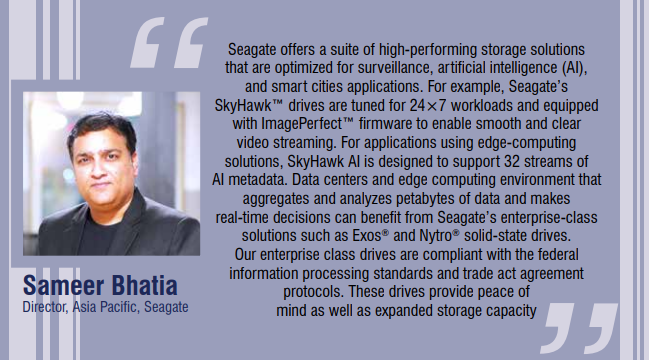
Global Data-sphere Evolution
Data is in flight all around us and has become an essential part of the human experience.
The global market intelligence firm – IDC – forecasts that the global data-sphere will increase from 33 zettabytes in 2018 – where one zettabyte equals to a trillion gigabytes – to 175 zettabytes in 2025. That is by 2025, on an average every connected person in the world will have a digital data engagement over 4900 times per day. This breaks down to about 1 digital engagement every 18 seconds. IDC reports that the number of IoT devices will grow to 80 billion by 2025, and these smart solutions will monitor business processes and enhance everyday life activities.
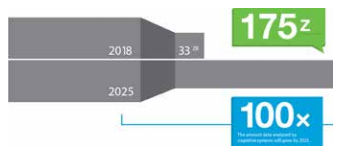
Harnessing the Power of Data
Executives are ultimately looking to interpret the data aggregated by IoT devices, sensors and security solutions, and leverage it to improve operations, cost-savings and customer satisfaction. The deployments of cognitive systems such as machine learning, natural language processing and AI that actively analyze this data for proactive decision-making are on the rise. IDC indicates that the amount of analyzed data that is ‘touched’ by cognitive systems will grow by a factor of 100 to 1.4 zettabytes in 2025. The use of cognitive systems is opening the door to new business opportunities and a greater return on investment in all markets.
Storage in the Era of AI
New enhancements allowing security solutions to be used for business intelligence are driving the demand for data-hungry applications. The increased use of AI systems in security has warranted a shift in recording and storage technologies. Standard surveillance systems primarily recording footage were typically write-only applications. Today surveillance systems with AI have mixed read/ write workloads. Previously, users relied on cloud data centers to manage the unstructured data and analysis. However, this setup often causes latency and delays as all video and metadata must be transferred off-site for analysis.
To remedy this issue, storage providers are building AI into video NVR systems and harnessing the power of micro-datacenters so that initial processing, analysis and pattern recognition may occur in real time at the edge. The edge refers to servers and appliances outside of data centers that are located regionally and are closer to endpoints, like surveillance cameras and sensors, where the data is first captured.
Development of AI-enabled NVRs and edge computing devices is driven by cheaper graphics processing units (GPU) with enhanced analysis capabilities, as well as better storage options. In particular, new hard disk drives with fast writing data speeds, high read performance, and support for both AI and video workloads have become attractive solutions for system integrators. Innovation in telecommunications with 5G, advanced sensors and intelligent surveillance cameras are also driving the evolution of surveillance beyond traditional security for AI applications.
After the initial video ingestion and analytics at the edge, video is pushed to the back end or cloud. In this centralized environment, video and AI metadata are consolidated for deep learning activities to train the system to be more predictive and provide a more holistic view of the video data collected. In the past, users primarily used cloud storage to satisfy legal and corporate retention policies; however, that has since changed. Data no longer languishes in the back end to eventually be discarded. Now data in the cloud is used to bring predictive power and intelligence for better decision-making like never before. Ultimately, implementing robust storage solutions from edge to cloud enables smarter surveillance systems over time through AI training and rapid insights for command center operators to quickly respond to time-sensitive scenarios.
Biggest Impact: Safe and Smart Cities
The development of safe and smart cities continues to be one of the sectors where surveillance systems and data will have the greatest impact. Research firm IHS Markit indicates that the global market for city surveillance exceeded $3 billion in 2017 and is expected to increase each year by 14.6% from 2016 through 2021. IHS reports that China is one of the strongest adopters of safe city surveillance technologies.

SMART CITY SECTORS
Beyond citywide surveillance, smart cameras, IoT sensors, and edge computing devices with AI are being deployed in smart cities to equip businesses and citizens with data that can enhance the urban experience. IHS Markit predicts that there will be at least 88 smart cities worldwide, a substantial increase from 21 cities in 2013. The collection and delivery of data is the crux of the smart cities operation.
Here are three segments within smart cities where organizations are using data to address urban woes.
HEALTHY LIVING AND SAFETY
Data captured by IoT devices and video are utilized to not only improve the quality of healthcare, but also the kind of preventative measures implemented to ensure a healthier population.
In hospitals, IoT sensors and video devices enable re mote patient monitoring, providing real-time alerts of blood pressure and other body indicators to staff who can intervene before a situation escalates to a crisis.
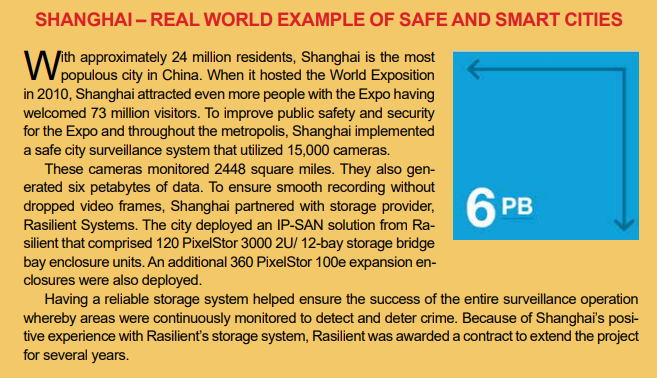
The end result is lower mortality rates. When it comes to preventive health measures, advanced IoT devices and video solutions are employed for air quality monitoring, alerting sensitive groups to potentially dangerous 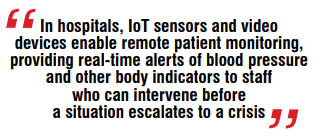 conditions. Population health programs are using data collection and analysis of large sample sizes to identify the demographics most at risk for specific health issues. With data driven insights, these entities provide citizens with more tools such as free wellness guides to inspire behavior changes that mitigate the risk for certain health conditions. Safe city policies that reduce violence and crime rates also aid in keeping healthy citizens out of healthcare facilities. Body-worn cameras, video cameras with analytics, gunshot detectors, and home security systems are some of the notable technologies enhancing public safety efforts. These sensors enable real-time crime mapping and predictive policing, which can help reduce assault, robbery and burglary incidents by 30% to 40%, according to McKinsey Global Institute’s 2018 Smart Cities report.
conditions. Population health programs are using data collection and analysis of large sample sizes to identify the demographics most at risk for specific health issues. With data driven insights, these entities provide citizens with more tools such as free wellness guides to inspire behavior changes that mitigate the risk for certain health conditions. Safe city policies that reduce violence and crime rates also aid in keeping healthy citizens out of healthcare facilities. Body-worn cameras, video cameras with analytics, gunshot detectors, and home security systems are some of the notable technologies enhancing public safety efforts. These sensors enable real-time crime mapping and predictive policing, which can help reduce assault, robbery and burglary incidents by 30% to 40%, according to McKinsey Global Institute’s 2018 Smart Cities report.
MOBILITY
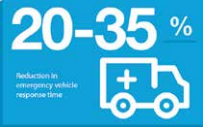
Traffic congestion and roadway infrastructure are often the top struggles that growing metropolises face. Intelligent traffic lights allow for optimized routes based upon mobility patterns. As a result, roads are made safer, commutes can be shortened, and emergency response times are reduced by as much as 20% to 35%, as stated by the McKinsey Global Institute. Parking shortages, another common challenge for thriving cities, can also be ameliorated. Advanced parking systems that use sensors to determine occupancy levels help drivers determine space availability, creating a better user experience. Interconnected smart city technology also provides the infrastructure framework for autonomous vehicles, vehicle-to-vehicle (V2V) and vehicle-to-infrastructure (V2I communications, helping in identifying pedestrians approaching intersections, road hazards and accidents in real time. All of this data is being acted upon to ease congestion and improve traffic flow.
ECONOMIC DEVELOPMENT, HOUSING AND COMMUNITY ENGAGEMENT

Deploying smart city technology can have positive economic impacts, enabling urban centers to better appropriate resources and disseminate information to residents. Smart energy usage meters allow for more frequent readings and energy consumption tracking, providing citizens with information that can be used to facilitate lifestyle adjustments that generate cost savings. With a smart water meter and monitor, families can assess how much water was used for a particular sprinkler interval and choose whether to water lawns for a shorter amount of time. McKinsey Global Institute reports that water consumption tracking systems can help reduce residential water usage by as much as 15% in cities.
Additionally, platforms are becoming available to the public providing helpful insights such as roadblocks to avoid, disturbances to be aware of, and inviting real-time incident reporting.
The result is enhanced safety and community engagement. For enterprises, smart sensors deliver valuable insights about the local population, such as high foot-traffic areas. Business owners may use this information to choose the best business location, maximize advertisement placements, and deliver more focused marketing messages, which creates a higher marketing ROI.
STORAGE CONSIDERATIONS FOR DATA HUNGRY APPLICATIONS
To accommodate this deluge of data collection for smart cities and other AI deployments, system integrators and solution architects need to ensure they have the proper stor age configuration. Otherwise, customers will be subjected to dropped frames and data loss, which inhibits deep learning and predictive analysis.
Here are the top storage best practices for security professionals.
IMPLEMENT IT 4.0 ARCHITECTURE
I n this era of unprecedented data collection and analysis, a new storage architecture is needed. Because of the plethora of sensors used for advanced applications, integrators can no longer rely on the cloud alone as a viable or even cost-effective solution. Instead, integrators need to deploy high-performing storage solutions at each stage of the data flow, from the endpoints, edge and cloud. This is referred to as IT 4.0
By implementing IT 4.0 architecture, which leverages high-performing Seagate Technology hard drives at every stage of the data workflow, security personnel improve data capture, real-time analysis, preservation and protection.
SELECT THE RIGHT HARD DRIVE
Not all hard drives are created equal. When it comes to powering the DVR, NVR, or even server, it is to choose a hard drive that is purpose built for surveillance. Standard desktop drives are best suited for applications that operate 8 hours a day, 5 days a week. This is not the case for surveillance systems, especially for heavy analysis use cases. For AI and smart city deployments, cameras are recording 24×7, and storage systems often have longer retention periods for deep learning. Integrators would do well to utilize a hard drive like Seagate’s SkyHawk, and which are seventh-generation products optimized for surveillance with 3x the workload of typical desktop drives. They record up to 64 HD cameras – storing 10,000 hours of video – and feature ImagePerfect™ firmware to improve streaming. SkyHawk AI also supports 32 streams of AI metadata. Built-in rotation vibration sensors ensure SkyHawk and SkyHawk AI perform optimally in 16+ NVR bay environments. For centralized storage locations that need to scale to petabytes of data from thousands of cameras, Seagate features higher capcities, SED and cybersecurity features. Seagate also improve speed SkyHawk AIExos enterprise-class drives, Nytro solid-state drives, and performance for blade servers managing hot data.
EMPLOY DRIVE MONITORING SOFTWARE
To ensure the longevity of the overall surveillance and storage system, it is to select hard drives with embedded monitoring software such as SkyHawk Health Management (SHM). Built into SkyHawk drives, SHM provides continual updates on how the drive is operating, and makes recommendations to improve functionality and limit deterioration. SHM may alert the user to modify the temperature settings to keep the drive from overheating. Before a drive fails, SHM will recognize the symptoms and recommend a backup. By using SHM, integrators can proactively support surveillance systems with prevention, intervention, and recovery from adverse conditions. Gaining live alerts on potential issues or threats reduces the need for costly maintenance services.
ENROLL IN DATA PROTECTION SERVICE
For additional peace of mind, integrators should opt into data recovery services. In the event of a power outage, vandalism, equipment malfunction or natural disaster, customers can still retrieve their data for up to two years with Seagate’s Rescue Data Recovery Services plan.
RIGHT PLACE, RIGHT TIME, RIGHT SOLUTION
From small businesses to large enterprises to smart cities, entities are relying on data to improve operations, safety and the user experience. Thanks to AI, integrators and solution architects are using IoT devices, surveillance cameras, and other sensors to capture data in more creative ways. However, this data is rendered useless unless it is securely recorded, analyzed and delivered for actionable results. It is critical that robust storage systems are implemented from edge to cloud for intensive recording and heavy analysis applications. When powered by the right drives optimized for 24×7 workloads, these storage systems can accommodate everything from real-time data aggregation and analytics to deep learning in the cloud.
By implementing the best storage architecture and technologies, businesses can leverage data in real time to respond more quickly to high-risk scenarios and make smarter decisions that have a tangible impact.
